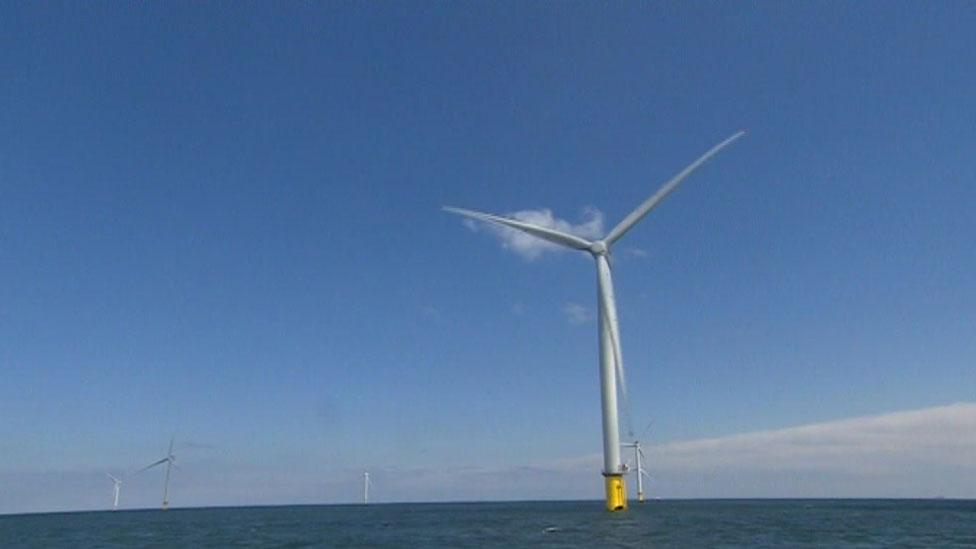Berwick Bank offshore wind farm project approved for North Sea – BBC

Report on the Approval of the Berwick Bank Offshore Wind Farm and its Implications for Sustainable Development Goals
The Scottish government has granted approval for the Berwick Bank offshore wind farm project. This decision highlights the complex interplay and inherent tensions between several key United Nations Sustainable Development Goals (SDGs), particularly the drive for clean energy and climate action versus the imperative to protect biodiversity.
Project Overview and Alignment with SDG 7 and SDG 13
The Berwick Bank project, developed by SSE Renewables, represents a significant advancement in renewable energy infrastructure. Its approval is a direct contribution to achieving specific SDG targets.
- SDG 7: Affordable and Clean Energy: The wind farm is projected to generate sufficient electricity to power every household in Scotland twice over, substantially increasing the share of renewable energy in the national energy mix and enhancing energy security.
- SDG 13: Climate Action: As one of the world’s largest offshore wind farms, the project is a major step in Scotland’s strategy to achieve net-zero emissions. Government officials, including Deputy First Minister Kate Forbes and UK Energy Secretary Ed Miliband, have framed the approval as critical for tackling the climate crisis and making Britain a “clean energy superpower.”
Key project details include:
- Location: Approximately 23 miles (38km) off the east coast of Scotland in the North Sea.
- Scale: Up to 307 wind turbines.
- Objective: To deliver homegrown, affordable, and secure clean energy, reducing reliance on fossil fuels.
Contribution to SDG 8: Decent Work and Economic Growth
The project is anticipated to provide substantial economic benefits, directly supporting the objectives of SDG 8.
- Job Creation: The development is expected to create thousands of jobs over its lifetime.
- Economic Investment: SSE Renewables projects an injection of £8.3 billion into the economy, fostering sustainable economic growth and opportunity in Scotland.
Conflict with SDG 14 and SDG 15: Biodiversity and Life Below Water/On Land
Despite its climate and energy benefits, the project’s approval has been met with significant opposition from conservation organizations due to its severe potential impact on marine and coastal ecosystems, placing it in direct conflict with biodiversity-focused SDGs.
Conservationist Concerns
- SDG 14 (Life Below Water) & SDG 15 (Life on Land): Conservation groups, led by RSPB Scotland and the National Trust for Scotland, have warned that the project could be “catastrophic” for globally significant seabird populations. The wind farm’s proximity to the St Abb’s Head National Nature Reserve and the Bass Rock is a primary concern.
- Predicted Impact: It is predicted that the turbines will cause the deaths of tens of thousands of seabirds, potentially pushing some species toward extinction and undermining efforts to halt biodiversity loss.
Governance and Mitigation: Balancing Competing SDGs
The Scottish government’s decision reflects an attempt to balance competing sustainable development priorities. The approval is conditional upon measures intended to mitigate the negative environmental impacts, demonstrating a governance approach to managing SDG trade-offs.
Required Actions
- Mandatory Compensation Plan: The approval is contingent on SSE Renewables producing a detailed seabird compensation plan.
- Ministerial Approval: This plan must be approved by Scottish ministers before the project can proceed, ensuring that measures to address the adverse impacts on biodiversity (SDG 14 & 15) are formally reviewed and deemed adequate.
This case underscores the challenge of pursuing SDG 17 (Partnerships for the Goals), as it involves navigating the conflicting objectives of government, industry, and civil society to achieve a sustainable outcome.
1. Which SDGs are addressed or connected to the issues highlighted in the article?
-
SDG 7: Affordable and Clean Energy
- The article’s central theme is the approval of the Berwick Bank offshore wind farm, a massive renewable energy project. It is described as being able to “generate enough electricity to meet the annual energy needs of every household in Scotland twice over” and deliver “homegrown, affordable and secure clean energy.” This directly aligns with the goal of increasing access to clean energy.
-
SDG 13: Climate Action
- The project is explicitly framed as a measure to combat climate change. Deputy First Minister Kate Forbes states the approval is “a major step in Scotland’s progress towards achieving net zero and tackling the climate crisis.” This connects the project to national strategies for climate action.
-
SDG 8: Decent Work and Economic Growth
- The economic benefits of the wind farm are highlighted throughout the article. It is mentioned that the project has the “potential to create thousands of jobs” and “inject £8.3bn into the economy over its lifetime,” which supports the goal of promoting sustained, inclusive, and sustainable economic growth.
-
SDG 9: Industry, Innovation, and Infrastructure
- The construction of “one of the world’s largest offshore wind farms” with “up to 307 turbines” represents a significant development in building resilient and sustainable infrastructure. It is an investment in clean technology to upgrade the country’s energy infrastructure.
-
SDG 14: Life Below Water & SDG 15: Life on Land
- These goals are addressed through the significant conflict presented in the article. The wind farm is located in the North Sea, impacting marine ecosystems (SDG 14). The primary concern is its effect on seabirds, which are part of both marine and coastal/terrestrial ecosystems (nesting on land at reserves like St Abb’s Head). Conservationists warn the project could be “catastrophic for Scotland’s globally important seabirds” and “catapult some… species towards extinction,” highlighting a direct threat to biodiversity.
2. What specific targets under those SDGs can be identified based on the article’s content?
-
Target 7.2: By 2030, increase substantially the share of renewable energy in the global energy mix.
- The article states the project will “rapidly scale-up Scotland’s operational renewable energy capacity” and help “deliver clean power by 2030.” This directly contributes to increasing the proportion of energy generated from renewable sources.
-
Target 13.2: Integrate climate change measures into national policies, strategies and planning.
- The Scottish government’s decision to approve the project is presented as a deliberate policy choice to advance its climate goals, specifically “achieving net zero and tackling the climate crisis.” This demonstrates the integration of climate objectives into national energy and infrastructure planning.
-
Target 8.5: By 2030, achieve full and productive employment and decent work for all women and men…
- The article points to this target by mentioning the project’s potential to “create thousands of jobs” and “clean power jobs in Scotland,” contributing to employment opportunities.
-
Target 15.5: Take urgent and significant action to reduce the degradation of natural habitats, halt the loss of biodiversity and, by 2020, protect and prevent the extinction of threatened species.
- This target is highlighted by the conflict at the heart of the article. Conservation groups’ warnings that the project will “kill tens of thousands of seabirds” and could lead to the “extinction” of some species show that the project is in direct opposition to the goal of halting biodiversity loss. The government’s requirement for a “seabird compensation plan” is a response to these concerns.
-
Target 14.2: By 2020, sustainably manage and protect marine and coastal ecosystems to avoid significant adverse impacts…
- The project’s location in the North Sea and its proximity to important seabird colonies like the Bass Rock places it squarely within the scope of this target. The debate over its approval revolves around whether the economic and climate benefits outweigh the “significant harm to the seabird colonies.”
3. Are there any indicators mentioned or implied in the article that can be used to measure progress towards the identified targets?
-
Indicators for Energy Production (SDG 7)
- Amount of renewable energy capacity added: The project consists of “up to 307 turbines” and is described as “one of the world’s largest offshore wind farms.” The total generating capacity would be a key indicator.
- Proportion of energy needs met by renewables: The article provides a powerful, albeit qualitative, indicator by stating the farm could “generate enough electricity to meet the annual energy needs of every household in Scotland twice over.”
-
Indicators for Economic Impact (SDG 8)
- Number of jobs created: The article explicitly mentions the potential to create “thousands of jobs.” The actual number of jobs created would be a direct indicator.
- Economic investment/value added: The project is expected to “inject £8.3bn into the economy over its lifetime,” which serves as a financial indicator of its economic contribution.
-
Indicators for Biodiversity Impact (SDG 14 & 15)
- Number of animal fatalities: The prediction that the project will “kill tens of thousands of seabirds” is a direct, negative indicator of its impact on biodiversity.
- Change in species population: The National Trust for Scotland’s plan to be “monitoring bird populations at the reserve” will generate data on population trends, which is a core indicator for measuring biodiversity loss or stability.
- Mitigation measures implemented: The requirement for a “detailed seabird compensation plan” is a policy-based indicator that can be assessed for its effectiveness in mitigating the negative impacts.
4. Table of SDGs, Targets, and Indicators
| SDGs | Targets | Indicators |
|---|---|---|
| SDG 7: Affordable and Clean Energy | 7.2: Increase substantially the share of renewable energy in the global energy mix. | Amount of electricity generated, sufficient to power “every household in Scotland twice over.” |
| SDG 13: Climate Action | 13.2: Integrate climate change measures into national policies, strategies and planning. | The project’s approval as a “major step” towards “achieving net zero and tackling the climate crisis.” |
| SDG 8: Decent Work and Economic Growth | 8.5: Achieve full and productive employment and decent work. | Creation of “thousands of jobs” and an injection of “£8.3bn into the economy.” |
| SDG 9: Industry, Innovation, and Infrastructure | 9.1: Develop quality, reliable, sustainable and resilient infrastructure. | Construction of a large-scale renewable energy project with “up to 307 turbines.” |
| SDG 15: Life on Land | 15.5: Halt the loss of biodiversity and prevent the extinction of threatened species. | Predicted number of fatalities (“tens of thousands of seabirds”) and results from “monitoring bird populations.” |
| SDG 14: Life Below Water | 14.2: Sustainably manage and protect marine and coastal ecosystems. | The existence and details of the required “detailed seabird compensation plan” to mitigate adverse impacts. |
Source: bbc.com

What is Your Reaction?
 Like
0
Like
0
 Dislike
0
Dislike
0
 Love
0
Love
0
 Funny
0
Funny
0
 Angry
0
Angry
0
 Sad
0
Sad
0
 Wow
0
Wow
0



























;Resize=805#)



















































